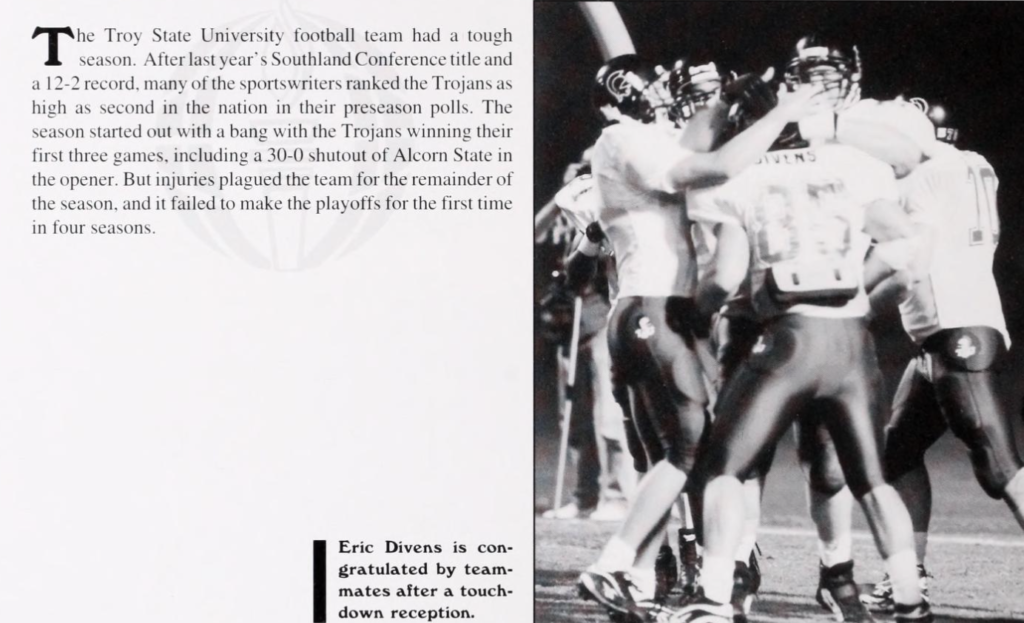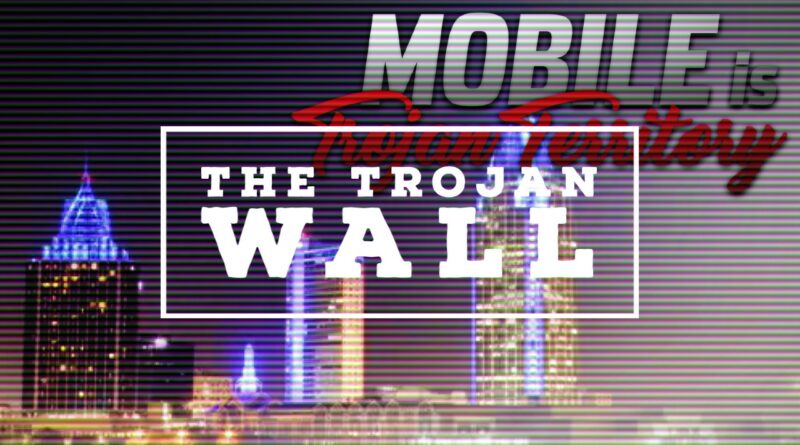Trojan Territory: Troy Football in Mobile
This Saturday was supposed to be the fifth “Battle for the Belt” so here at The Trojan Wall we’re doing Five Stories in Five Days. Our final installment takes a look at Troy’s “home away from home.”
Troy’s annual booster tour touts each city as “Trojan Territory,” a way to unite supporters in that town despite the fact they aren’t in the Wiregrass. For example, “Dothan is Trojan Territory” was the slogan for the event held in the Circle City.
That slogan borders on petty when it includes the city in which Troy’s rival is located. (Which is perfectly fine this week. I have no problem with petty.)
It made me wonder though, is that slogan true? To what extent is Mobile Trojan Territory? The team has played at least three bowl games in Ladd, and half of the rivalry took place there too.
Turns out, it’s not inaccurate to claim the Port City as Trojan Territory—as long as you start counting after World War II. Since then, Troy is 9-2. Before that, it was a lot uglier.
The Spring Hill Series (0-5, 1934-1940)



Today, Spring Hill College is a Division II school, playing most of its sports in the Gulf South Conference, and not playing football at all. When the War broke out, Spring Hill’s team fell apart. Unlike Troy, Georgia Southern or many other colleges, the Badgers have not returned to the gridiron.
That may be a good thing for Troy. The two teams met five times from 1934 to 1940, and the Trojans/Teachers/Red Wave didn’t score a single point. The Badgers beat Troy by a wider margin each time—scoring 66 points in five games—and every game was played in Mobile.
The shutouts must have left an impression on the Trojans. They didn’t come back for more than a half century.

The Move to Division I (3-0, 1996-2002)

Troy State moved to Division I in the early 1990s, and though the Trojans never brought home a I-AA title, they made an almost annual appearance in the playoffs. As the screen grab from the Palladium yearbook shows, Troy finished 1995 with an 11-1 record and a top-five ranking.
The next year, the Trojans took their 3-1 record to play Alabama State in Ladd-Peebles Stadium, at least 200 miles from either campus. The Trojans rolled 37-6, earned a 12-2 record and ended the year with another national ranking.
Looking to capture that magic, Troy met Alcorn State in Mobile. The Trojans again blew out the opponent, this time 30-0. Troy State continued to dominate the conference before it finally made the jump in 2001.
It’s not clear whether these two games were part of the Azalea City Classic, an annual I-AA/FCS/HBCU game played at Ladd for several years. What is known is in 2002, Troy did take part in that game, going up against a familiar foe: Florida A&M.
The Trojans played the Rattlers in the 1996, 1998 and 1999 FCS playoffs. In those last two games, A&M tied up the series that included a 1984 matchup.
Troy retook the series lead with a 24-7 win. Troy was now 3-5 in Mobile, and 3-0 since World War II.

The Sun Belt Years (5-2, 2010-present)




Troy’s first few bowl games were either in California or New Orleans. In 2009, the ACC was set to send a team to the GMAC Bowl in Mobile. It didn’t have enough teams, so the bowl turned to Notre Dame. The Irish said no, and the New Orleans Bowl passed on Troy to avoid a Troy-Southern Miss rematch.
So Troy ended up taking on Dan LeFevour and Central Michigan in Mobile. We already know how painful that game was, so let’s just say Troy’s first bowl game in Mobile was its first loss in the zip code in 70 years.
Then came the Belt. Troy won the first game, before Larry Blakeney gave up the ghost. Troy lost in Mobile for a seventh time, the second since World War II, and hired some guy whose middle name is Harmon.
Since then Troy has won five straight games in Mobile, including two more bowl appearances.
The 9-2 postwar record almost applies specifically to Ladd-Peebles Stadium. That venue is basically Veterans Memorial Stadium South, but in 2020 the Jaguars finally moved into their own home: Hancock Whitney Stadium.
Troy’s first game in the Jags’ new digs was Steve Campbell’s last. Chip Lindsey’s Trojans kept the streak alive, shutting out the Jaguars at home for the first time ever and sending the former Trojan packing.
Now, two years later, both coaches’ successors are on hand for the second Battle for the Belt in Hancock Whitney Stadium.

If Troy takes down South, it will hold onto its Mobilian win streak for an entire decade by the time it returns to HWS.
Regardless it’s pretty safe to claim Mobile as Trojan Territory.
Be sure to check out our other #SouthHateWeek stories!
Before the Belt: the Rivalry Across the Years
Battle for the Belt 101
Mel Lucas: The First Link
The Battle for the Belt Uniform History
Reuniting Champions

